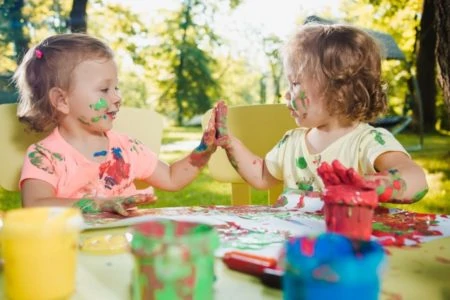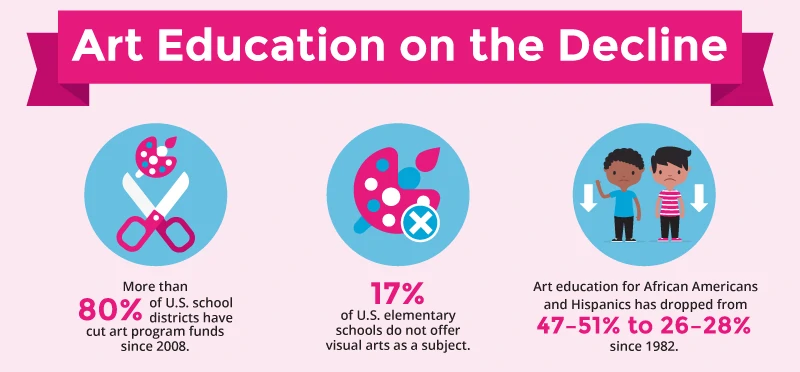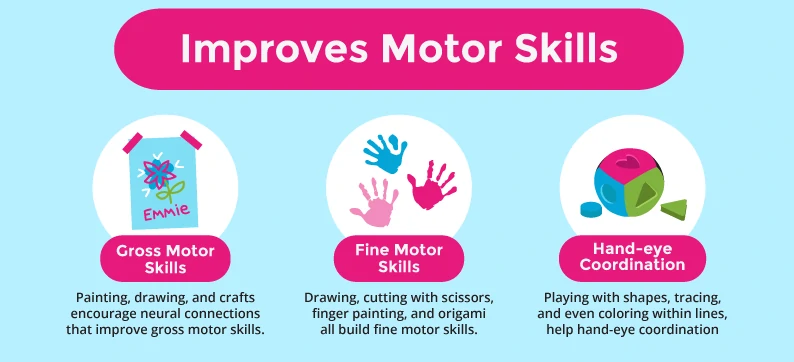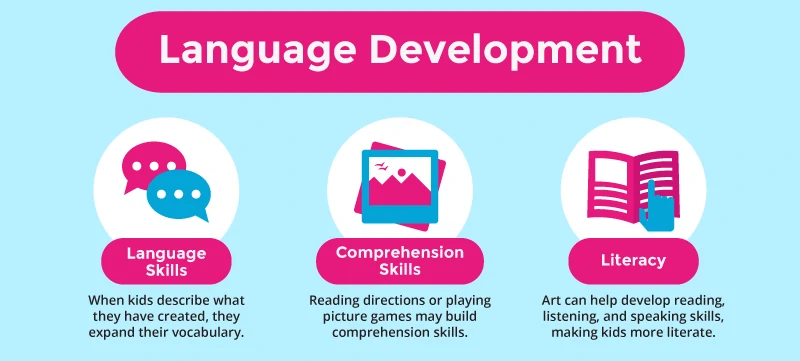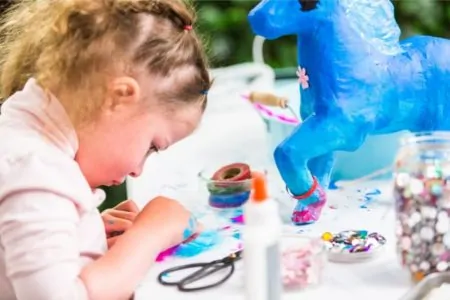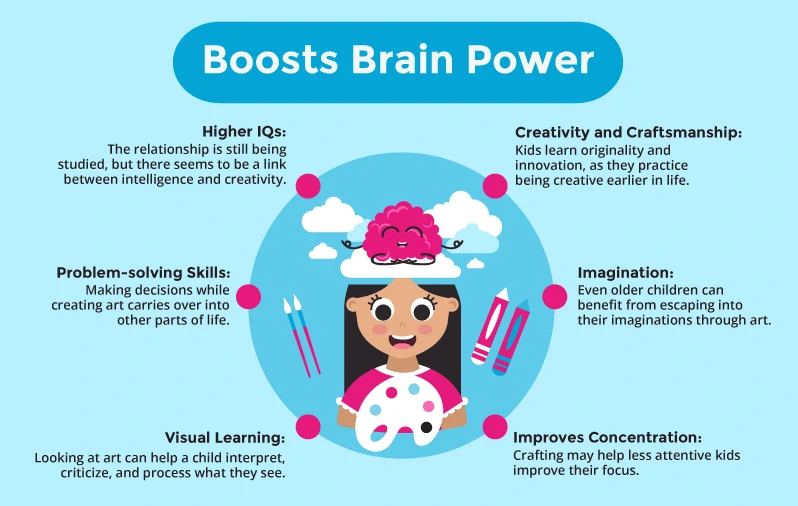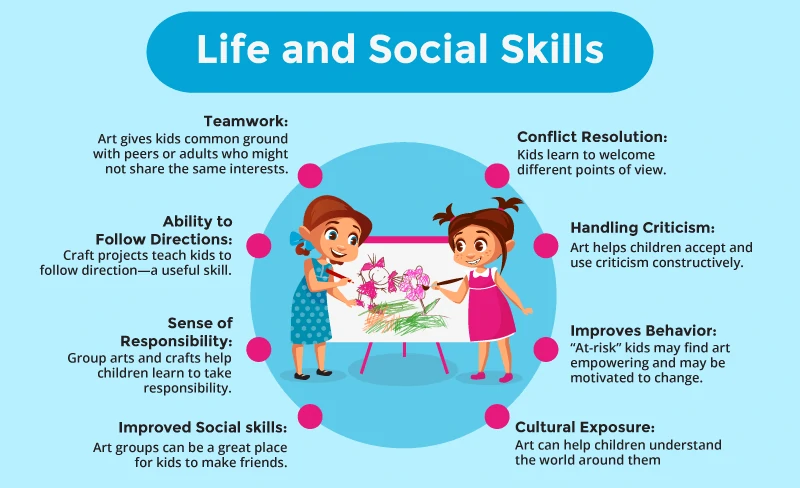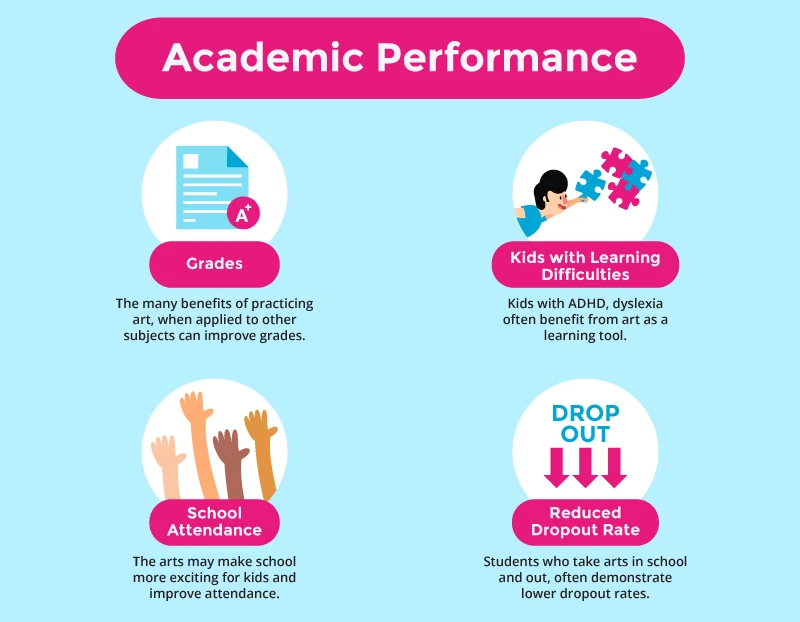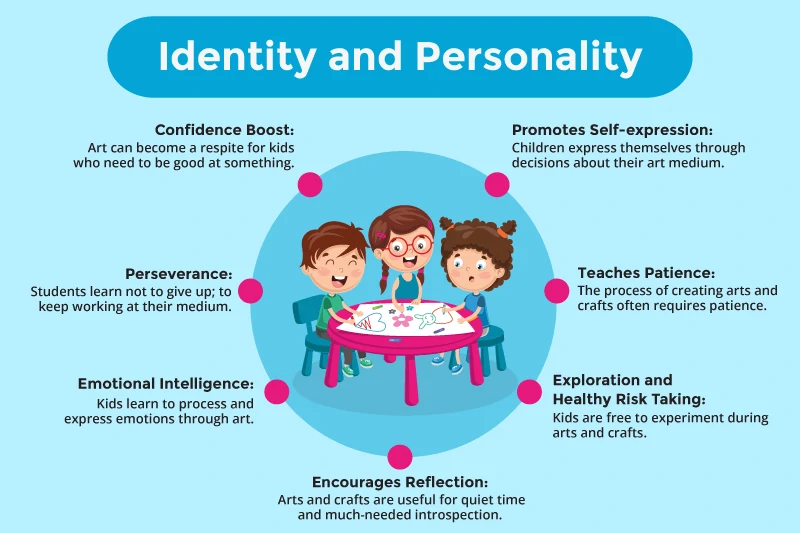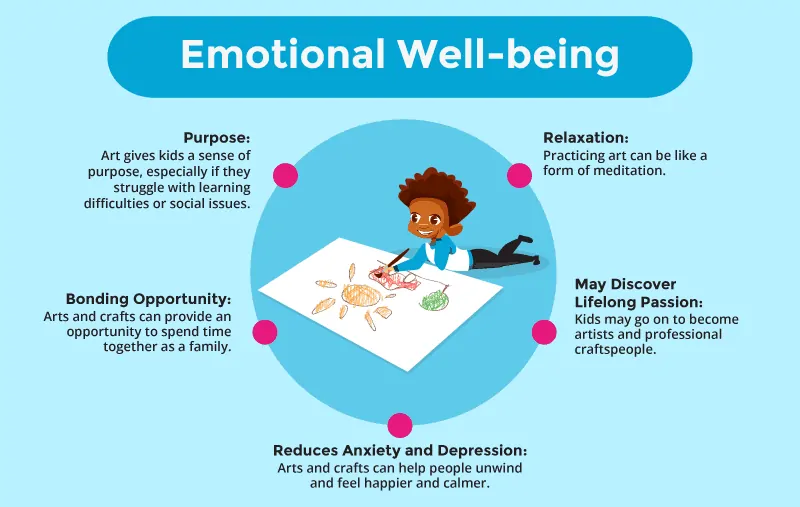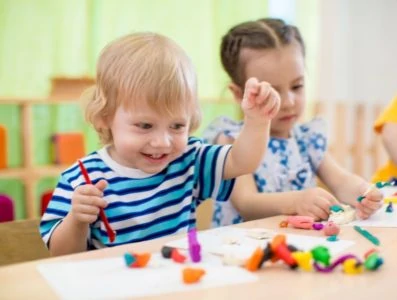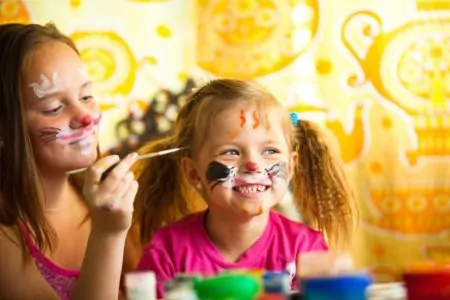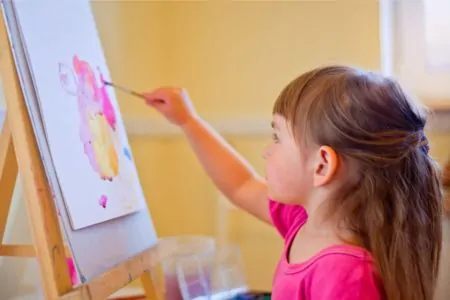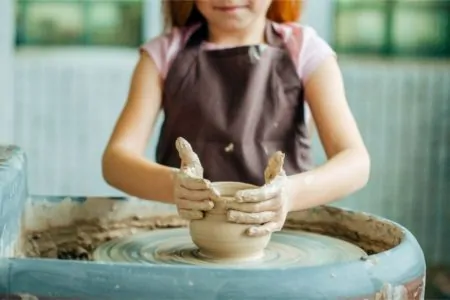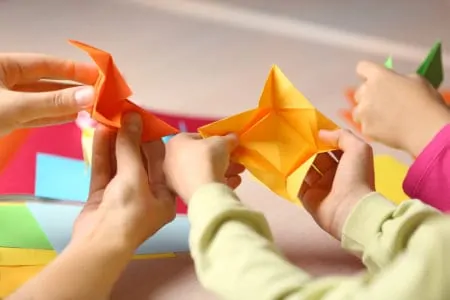Do you view art as just messy playtime for kids? Or do you realize it’s so much more than that? Art can be good for kids in many ways.
While a child needs to learn science, math, and reading, art is also key to their development. At home, it’s a great time to connect with your child and encourage their creativity. In school, it’s a way for them to communicate and build confidence.
With art education on the decline in schools all around the world, it’s up to us as the parents to inspire, introduce and cultivate the little Piccaso in each child.
Let’s take a look at what art is, its benefits, and how you can help get your kids involved.
Is Art Education on the Decline?
Statistics show that art benefits children’s academic achievements. Those students actively involved in the arts are:
- Four times more likely to take part in a math or science fair.
- Three times more likely to have good school attendance and win an award for it.
- Four times more likely to be recognized and acknowledged for academic achievements.
- Three times more likely to stand for and be elected to class office.
- Likely to have higher SAT scores.
- Less likely to drop out of school.
- More likely to gain employment after school due to their creativity.
Despite these facts, many educators feel not enough emphasis is being placed on art in schools. 66 percent of public school teachers feel that arts are being overtaken by the need for math or language arts.
Art Education In Decline
There has also been a steady decline in the availability of arts education for African Americans and Hispanic Americans. Between 1982 and 2008, it dropped from 47–51 percent to 26–28 percent (1).
A more recent report, The Nation’s Report Card, carried out by the National Center for Education Statistics, was compiled in 2017. This showed that students who take music lessons or art classes, go to the theater, or visit museums, achieve higher scores in their tests (2).
These facts and figures represent an overwhelming reason for getting our kids interested in creative pastimes at an early age.
This is where you, as a mom or dad come in. If these facilities are not being offered on the scale they should be in school; then you can help.
Start by fostering your child’s artistic appreciation at home. This can be done as simply as encouraging fingerpainting in toddlers. As they grow, you can introduce them to other creative activities.
Benefits of Arts and Crafts for Kids
While we have established there are different types of art, we will concentrate on the benefits of fine/visual arts and crafts for kids.
It’s worth pointing out art is beneficial for everyone. Historically, art has depicted how different civilizations lived and what their cultures and traditions were.
Art can also be used as therapy. It can help people overcome the effects of illnesses, or it may calm a troubled mind.

It can help people earn a living, with skills like architecture and commercial or advertising art.
Theater and music bring people together socially, and can also be a form of personal expression.
So, what are the ways art can benefit our kids? Let’s take a look at them.
1. Motor Skills
There are a few types of motor skills that benefit from arts and crafts. These include:
- Gross motor skills: These are the movements of the large muscles of the arms, legs, and torso, which aid balance and coordination with our nervous system. Art activities such as painting, drawing, crafts, and scribbling encourage the connections between the brain and these muscles. Try activities like murals, which make them stretch, or pottery, which involves working with clay (3).
- Fine motor skills: These involve the smaller muscles in the fingers and hands. Exercising these muscles helps with writing, tying shoelaces, turning the pages of a book, using scissors, and so much more. Try activities like drawing — even if it’s just scribbling, cutting with scissors, finger painting for little ones, face painting, or origami for older kids (4).
- Hand-eye coordination: When drawing, painting, or doing any other intricate task, it’s our eyes that guide our hands to do our bidding (5). Playing with different shapes, tracing, connecting the dots, and even coloring within lines, help hand-eye coordination.
2. Language Development
Different types of art can help our kids develop their vocabulary and communication skills.
- Language skills: Art gives kids an opportunity to talk about colors, shapes, and what they are doing. They can describe what they have painted, scribbled, or created, helping them to communicate and expand their vocabulary. Art appreciation can help younger kids describe what they see, learning to put their thoughts into words (6).
- Comprehension skills: Arts and crafts can help kids understand the world around them in many ways. Reading directions for how things are done, or working out how to do something, can aid their comprehension. Play a game with young kids, like Pictionary, where they draw a picture to describe a word or use computer graphics with older kids.
- Literacy: Art can help develop writing, reading, listening, and speaking skills, making a child more literate. Encourage them to look at illustrations and match them to the text of a story, or express themselves through dance, music, or drama.
3. Boost Brain Power
Art can help our brains develop in many ways. These include:
- Higher IQ: There might be a relationship between creativity and higher IQs. That being said, this relationship is still under investigation (7).
- Improve problem-solving and critical thinking skills: Give two kids the same challenge and see how they will each approach it differently. It could be making something from an array of items, like rubber bands, paper towel tubes, cotton balls, or paper clips. They will learn to think constructively about what they are doing and work out ways to help them achieve their goal (8).
- Visual learning: Looking at art can help a child interpret, criticize, and process what they see. These skills can be applied to many other aspects of their lives. A child who is a visual learner will likely enjoy picture books or reading, and will often want to see how something is done before they attempt it themselves.
- Improve creativity and individual craftsmanship: Kids will learn to be original and innovative when using art as a medium from a young age. They will be able to express themselves and will work out which type of art they prefer.
- Imagination: Art in all its forms encourages a child to use their imagination. Escaping reality and entering the world they create can help with their well-being and mental health. Looking at and describing art can also promote a child’s imagination as they create their own stories about what they see.
- Improve concentration: Arts and crafts often lead to an end product. Following steps in sequence to complete a drawing or craft project can help a child focus and concentrate. This is especially the case if it’s something that interests them or is new to them.
4. World and Cultural Awareness
Using arts and crafts can help develop an awareness in children of the different traditions and cultures around the world. It can help them understand that not everyone has the same beliefs, and is a fun way to show that we are all equal.
It will help them understand and accept those who are different from them. It can also be a useful tool in preventing bullying. When a child knows that someone has different rituals, they won’t see it as outside the norm, and will be more likely to accept them.
You could help them draw an African tribal mask or make a Native American dreamcatcher. While doing this, explain the traditions behind these objects, and why they’re made.
5. Life and Social Skills
Life can be tough sometimes, and anything that helps a kid develop skills which benefit them in their journey is essential. Some of these can be provided by art, and include:
- Teamwork and collaboration: Whether it’s creating or appreciating art forms, it gives kids a chance to connect with their peers or adults who might not share the same interests. Talking about art or working together to create something that provides common ground.
- Ability to follow directions: Crafts often have specific instructions to complete a project. This could be following a knitting pattern, stitching a stuffed toy, or making clay figures. Being able to follow directions is a useful skill all through life.
- Improved social skills: Joining an art group, or even just collaborating on an art project in school, helps kids communicate. It’s also a great way for them to expand their social circle and make new friends.
- A sense of responsibility: Participating in arts or crafts as part of a group can help give kids a sense of responsibility. They might have their own piece of the project to look after and know that they are crucial to its successful completion.
- Ability to resolve conflicts: Art can help kids understand there is more than one way of looking at something. It will help them express points of view and work out solutions that are beneficial to everyone. Conflict can be seen as a chance to learn and grow.
- Handling criticism: Although there is no right or wrong with art, constructive criticism is a way that can help kids accept there is another point of view. This may be someone assessing their art, or them looking at the art created by others.
- Improving behavior: Participating in various arts, like music, drama, creative writing, and others, might help kids who are “at risk” to find motivation. It could improve their behavior as they learn to express themselves in healthy, productive ways, and take pride in their accomplishments (9).
6. Improved Academic Performance
There are conflicting schools of thought where art and academic performance are concerned. One thing that is agreed, though, is whether or not art improves academic performance, it still has a part to play in a child’s life.
- Influence on general school performance: Academic performance can be influenced by taking part in the arts. It doesn’t necessarily mean that art makes your child better at other subjects, like math and science. However, all the added benefits art provides can help a child achieve in other areas (10).
- Art can reach students with different learning styles: Kids with special needs, like ADHD, dyslexia, and sensory disorders, might not learn in the same way as other children when it comes to core subjects. With art, the field is leveled, as it’s subjective and doesn’t follow set rules and expectations. It can allow children with learning difficulties to match the performance of their peers, building self-esteem and confidence.
- Fosters regular school attendance: We mentioned some statistics earlier concerning the increased school attendance of kids who take part in arts. When kids have art as part of their curriculum, school becomes more fun to attend. Learning excites them more and they are less likely to be absent.
- Reduces school dropout rate: This is another statistic we touched on earlier. Students who take part in the arts, whether in school or outside, have a much lower dropout rate than those who don’t. In low socioeconomic groups, this can be five times lower.
7. Effects on Personality and Identity
Art can have beneficial effects on a child’s personality and sense of identity.
- Confidence boosting: No doubt, you praise your child’s achievements and help them gain a sense of self-worth. Art, however, teaches them self-respect and can be a respite for kids who need to excel at something. Feedback from peers, and learning to accept as well as give criticism, helps build self-esteem (11).
- Teaches perseverance: Whether it’s visual art, music, dance, or theater, art can help a child stick to something and see it through to the end.
- Teaches patience: Waiting for things to happen can be challenging for kids. It could be something as simple as waiting for glue to dry before moving to the next stage of a craft. Learning to hold back teaches them the value of patience.
- Emotional intelligence: The highs and lows that a kid experiences when creating can help them control their own emotions and be empathetic with others. It can also help them express their emotions and benefit their relationships with others (12).
- Encourages reflection and introspection: Life is busy, even for kids. There’s school, after-school clubs, sports, and more. Arts and crafts are a way of getting kids to have some quiet time and gives them a chance to think.
- Promotes self-expression: Art can give a kid an outlet to express themselves. Whether it’s choosing what color to use on a painting or which fabric to pick when crafting.
- Allows for exploration and healthy risk-taking: Experimenting during arts and crafts is a great way for kids to learn what works and what doesn’t. Maybe they decided painting something a particular color didn’t work and will change it next time. Seeing as there’s no right or wrong, they learn from what they might see as mistakes.
8. Emotional Well-being
Art can benefit kids emotionally and contribute to making them feel good about themselves.
- Gives a sense of purpose: Practicing arts and crafts can make kids more enthusiastic about other aspects of their lives (13). We have already mentioned the positive effect it can have on kids with learning difficulties, social issues, or problems with self-esteem.
- Bonding opportunity: Not only do kids form friendships and connect with their peers through art, but they also bond with their family. Taking some time out with your kids while painting, crafting, or doing any other type of art, gives you valuable family time.
- Reduces stress, anxiety, and depression: Arts and crafts of all kinds can help people feel happier and calmer. Interestingly, it’s not just while they’re doing it either. The effects can last into the next day, so encourage your kids to learn a craft and do it after school.
- Relaxation: Taking time out to concentrate on nothing else apart from creating what’s in front of you can be a great way to relax. It can distract kids from the ups and downs of everyday life and is like a form of meditation (14).
- May discover a lifelong passion: Although it’s not always the case, many kids who love art go on to become professionals in one of the fields they choose. This could be music, dance, or visual arts and crafts.
FAQs
In Conclusion
Arts and crafts benefit our kids in so many ways. Whether it’s painting, drawing, sewing, music, dance, theater, or any of the other arts, they all contribute to our children’s well-being. It helps them develop and learn to express themselves in different ways.
It’s important, as parents, we make sure that our children have access to the arts, both in and out of school. You never know, it might be the path to a career later in life. Even if it isn’t, it will ensure our kids grow up well-rounded.
